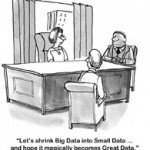 In the January/February issue of HR Magazine, Josh Bersin with Deloitte, makes nine predictions of “what’s in store for HR in 2015.” This is part seven of a series of nine articles looking at each of these predictions.
In the January/February issue of HR Magazine, Josh Bersin with Deloitte, makes nine predictions of “what’s in store for HR in 2015.” This is part seven of a series of nine articles looking at each of these predictions.
A sign on Albert Einstein’s door read: “Not everything that can be counted counts, and not everything that counts can be counted.” “Big data” is all the rage today, but does it really need to be all that big (think Neilson ratings) and is it really all that useful? Certainly data, statistics, and analytics are not new tunes that just hit the charts, particularly in the wonderful world of sports. Today we are using data, in both large and small businesses, to measure everything from behaviors such as a doctor’s bedside manner to data that could keep older drivers behind the wheel longer to data that reveals that employees who blog are happier Analytics involving more “clear cut” information such as economics, college admissions, and budgets will continue to prove useful. In addition, HR is now learning to use data for workforce planning. Moreover, data may help HR to obtain more of the business partner status it has been desiring for years.
It’s no secret that HR has not enjoyed a good reputation over the years and it has been waiting to be invited to “a seat at the table.” However, some wonder why HR has not “claimed” its seat at the table, by making itself more of a business partner. Unfortunately, many do not know where to begin to make such a transition happen. Analytics may be just the ticket. Let’s look at how analytics are changing the face of the workforce first.
As Mr. Bersin’s article states, HR does not need to go out and create a new song or purchase a new software package, but the concentration should be more on bringing already available data together. Just this past week, I had a coaching client, an HR executive, lament to me that her organization’s data is “all over the place.” Doctors Douthitt and Mondore suggest that while some vendors might posit that putting all the data in one place is where you should begin, the concentration should be on the integration of the data rather than trying to get it to one location. Trying to get the data in one place, just allows the same reports to be run with little change. Further, it wastes time that could be better put toward the integration process. Simply pull the data from various sources such as 360 assessments, employee opinion surveys, assessment results, performance assessments, training/LMS systems, and HRIS demographics. Deloitte suggests other sources such as recruiting, compensation, engagement, and leadership. Now you simply convert whatever data requires converting and make your comparisons. The doctors go on to poke a hole in the big data theory by stating that “for something to be impactful it does not necessarily have to be ‘sophisticated’ or ‘strategic’ in nature.” Gathering such data can help in several ways.
As Meghan Brio points out, data allows HR and other departments to be both descriptive and predictive, it is impartial (as long as the collection and reporting are conducted in an ethical manner), and it can be utilized in management decision making. Even more importantly, it can be used to strategize and meet organizational needs. For example, Thomas Davenport reports that Best Buy can now calculate that a .01% increase in employee engagement results in a $100,000 impact to its operational budget. AT&T and Google now use quantitative analytics to measure initiative as a better predictor of high performance on the job. Other organizations are still looking for those from prestigious schools. How can an HR department that is overwhelmed, underappreciated, and doesn’t read music (do numbers) achieve such lofty goals?
The good news is that there are several ways, the bad news is that it won’t be quick and doubtless it will carry some pain, but you must begin NOW. Start small by illustrating one piece of data such as an employee survey to illustrate its impact on a business need. This approach will be quick and help build interest and momentum. Use analytics and be sure to show cause and effect. For example when looking at collected data, both internal and external impacts should be reviewed and ask such questions as:
- What were economic conditions at the time?
- What was consumer trust, needs and demographics at the time?
- What was leadership like, was it on target, laissez-faire, dictatorial, effective?
- What hiring, succession policies, development programs, or processes were or were not in place at the time?
- What was the hiring market like?
Looking at these and other elements, some of which may be specific to your industry, will help provide a clearer picture of the data. Deloitte suggests creating a talent analytics team. This can take as long as two years. Other ideas are hire a consultant or even a graduate student to compile data and help interpret it and determine how it applies to current and future business needs.
Moving forward, be careful about jumping into technology, rather concentrate on building your team, HR personnel can learn to read music or master statistical analysis, and in doing so, HR can prove its value and contribute to business performance. Further, the human capital information gathered will provide your organization with a strong, competitive advantage.




